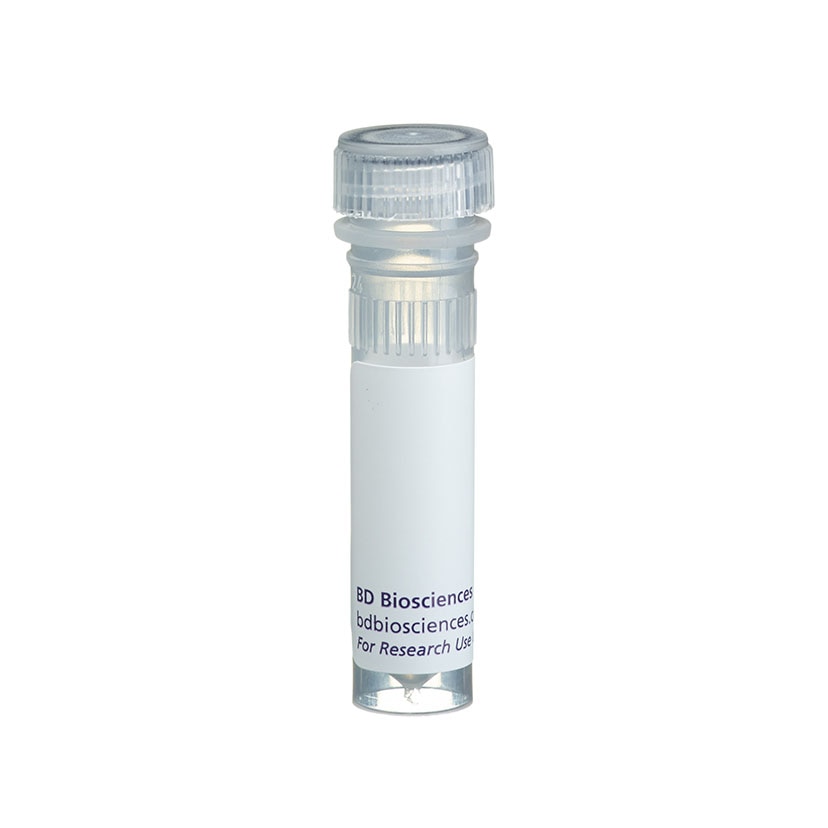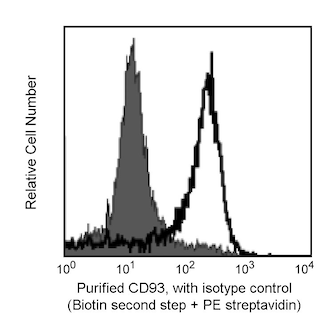Old Browser
Looks like you're visiting us from {countryName}.
Would you like to stay on the current country site or be switched to your country?




Expression of CD93 by unstimulated human peripheral blood mononuclear cells (PBMC). Human PBMC were stained with the purified NA/LE Mouse Anti-Human CD93 antibody (Cat. No. 552954, shaded histogram), or Purified NA/LE Mouse IgG2b, κ Isotype Control (Cat. No. 559530, open histogram). Secondary staining was carried out with Biotin Goat Anti-Mouse Ig secondary antibody (Cat. No. 553999) and PE Streptavidin (Cat. No. 554061). Fluorescence histograms depicting CD93 (or Ig Isotype Control) expression were derived from gated events with the side and forward light-scatter characteristics of viable PBMCs.


BD Pharmingen™ Purified NA/LE Mouse Anti-Human CD93

Regulatory Status Legend
Any use of products other than the permitted use without the express written authorization of Becton, Dickinson and Company is strictly prohibited.
Preparation And Storage
Product Notices
- Since applications vary, each investigator should titrate the reagent to obtain optimal results.
- An isotype control should be used at the same concentration as the antibody of interest.
- Please refer to www.bdbiosciences.com/us/s/resources for technical protocols.
Companion Products





.png?imwidth=320)
The R139 monoclonal antibody specifically binds to CD93 which is also known as Complement component C1q receptor (C1qR), C1q receptor 1 (C1qR1), or Matrix-remodeling-associated protein 4 (MXRA4). The immunogen used to generate the R139 hybridoma was a preparation of CD93 protein. Human CD93 is a transmembrane glycoprotein that is highly expressed on monocytes, macrophages, granulocytes, and endothelial cells but not on T and B lymphocytes. CD93 is also known as the C1q/MBL/SPA Receptor as it binds C1q, the recognition subunit of the first component (C1) of the complement pathway, as well as MBL (Mannose-binding-lectin) and SPA (Pulmonary Surfactant Protein A). Human C1qRp is involved in the C1q-mediated enhancement of phagocytosis. R139 is suitable to detect CD93 expression on cells of myeloid lineage by flow cytometry, and CD93 in cellular lysates by Western blotting or immunoprecipitation. In addition, R139 reportedly neutralizes C1q-mediated enhancement of phagocytosis. CD93 has also been reported to define a human stem cell population with hematopoietic and hepatic potential.
Development References (8)
-
Danet GH, Luongo JL, Butler G, et al. C1qRp defines a new human stem cell population with hematopoietic and hepatic potential.. Proc Natl Acad Sci USA. 2002; 99(16):10441-5. (Biology). View Reference
-
Guan E, Robinson SL, Goodman EB, Tenner AJ. Cell-surface protein identified on phagocytic cells modulates the C1q-mediated enhancement of phagocytosis. J Immunol. 1994; 152(8):4005-4016. (Immunogen). View Reference
-
Guan EN, Burgess WH, Robinson SL, Goodman EB, McTigue KJ, Tenner AJ. Phagocytic cell molecules that bind the collagen-like region of C1q. Involvement in the C1q-mediated enhancement of phagocytosis. J Biol Chem. 1991; 266(30):20345-20355. (Immunogen). View Reference
-
Nepomuceno RR, Henschen-Edman AH, Burgess WH, Tenner AJ. cDNA cloning and primary structure analysis of C1qR(P), the human C1q/MBL/SPA receptor that mediates enhanced phagocytosis in vitro. Immunity. 1997; 6(2):119-129. (Clone-specific). View Reference
-
Nepomuceno RR, Ruiz S, Park M, Tenner AJ. C1qRP is a heavily O-glycosylated cell surface protein involved in the regulation of phagocytic activity. J Immunol. 1999; 162(6):3583-3589. (Clone-specific). View Reference
-
Nepomuceno RR, Tenner AJ. C1qRP, the C1q receptor that enhances phagocytosis, is detected specifically in human cells of myeloid lineage, endothelial cells, and platelets. J Immunol. 1998; 160(4):1929-1935. (Clone-specific). View Reference
-
Prussin C, Metcalfe DD. Detection of intracytoplasmic cytokine using flow cytometry and directly conjugated anti-cytokine antibodies. J Immunol Methods. 1995; 188(1):117-128. (Methodology). View Reference
-
Tenner AJ. C1q receptors: regulating specific functions of phagocytic cells. Immunobiology. 1998; 199(2):250-264. (Biology). View Reference
Please refer to Support Documents for Quality Certificates
Global - Refer to manufacturer's instructions for use and related User Manuals and Technical data sheets before using this products as described
Comparisons, where applicable, are made against older BD Technology, manual methods or are general performance claims. Comparisons are not made against non-BD technologies, unless otherwise noted.
For Research Use Only. Not for use in diagnostic or therapeutic procedures.
Refer to manufacturer's instructions for use and related User Manuals and Technical Data Sheets before using this product as described.
Comparisons, where applicable, are made against older BD technology, manual methods or are general performance claims. Comparisons are not made against non-BD technologies, unless otherwise noted.
Report a Site Issue
This form is intended to help us improve our website experience. For other support, please visit our Contact Us page.